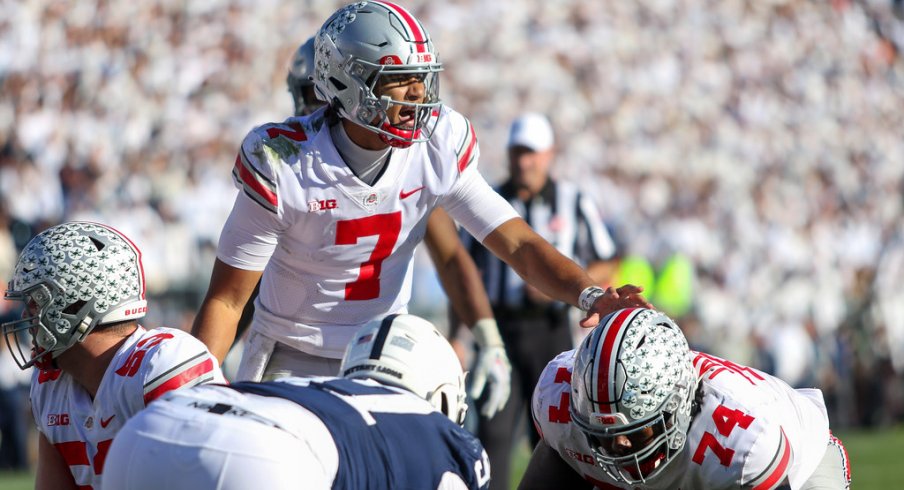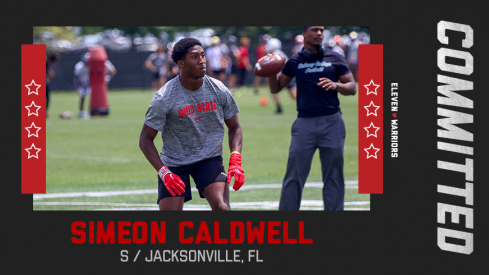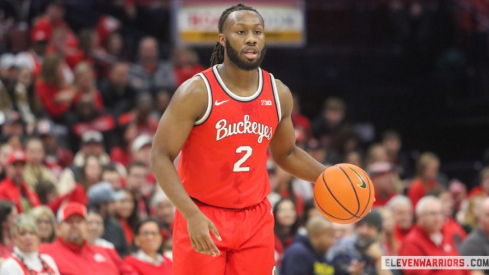Ohio State adds another top-100 safety as Simeon Caldwell commits to the Buckeyes.
Author's Note: In advance of Ohio State's matchup with Georgia in the Peach Bowl on December 31, Film Study will spend each week until then breaking down one aspect of the contest.
- December 8: Scouting the Georgia Defense
- December 15: Scouting the Georgia Offense
- Last week: Creating a Game Plan to beat Georgia
- Today: Ohio State's Keys to the Game
For nearly a month, we’ve dived deep into the Georgia football program. By this point, many of you can probably recite the names and numbers of many Bulldog players, and not just the stars, either.
We here at Film Study have watched hours of game film and past clinics featuring Kirby Smart and member of his staff. We’ve studied the statistics and even memorized sections of Smart’s playbook.
Yet none of the schemes or recruiting stars matter if the 11 players on the field don’t execute their jobs. It’s why games aren’t settled on paper, but instead on the field every Saturday in the fall.
That execution has been the foundation of the Georgia program for years, earning three CFP appearances and a national championship since Smart’s arrival. Now, the Bulldogs will act as Ohio State’s biggest hurdle in at least two years.
For the Buckeyes to overcome such an accomplished foe, it doesn’t mean certain players all of sudden transform into someone else, with C.J. Stroud magically borrowing Justin Fields’ legs or Zach Harrison transforming into a the third Bosa brother.
No, instead they will have to play their best game in 729 days, excelling in the little areas where they do already do well and minimizing errors elsewhere. If they succeed in following these three keys, the Buckeyes should earn a place in their second national title game in three seasons.
1) Communicate on Defense
As detailed two weeks ago, Bulldog coordinator Todd Monken has a penchant for using every shift, trade, and motion imaginable before the snap as a way of gaining leverage on an opponent. This volume of pre-snap movement may be more often in the NFL, but is not something the Buckeyes see very often in the Big Ten, and is relatively unique at the college level in general.
While it may seem like wasted movement to the general fan, in fact, it opens up the otherwise minimal seams that allow the UGA offense to succeed. Without a game-breaking talent at wide receiver who can take the top off the defense at any time, Monken instead tries to maximize small advantages by getting defenders to spend a fraction more time thinking instead of reacting.
Defenders that initially line up with the intention of playing one responsibility are often forced to quickly change on the fly, focusing as much on where they are supposed to line up rather than their new assignments.
There is no single solution to the myriad of problems all this pre-snap movement creates, but the most common response is to simplify the defensive call to something very straightforward and predictable. However, such a move makes Monken’s job even easier, as he can then attack the defense’s base call over and over.
Instead, the Buckeyes must not only have multiple responses to each type of movement, but all 11 players must get the call as quickly as possible. This will put particular strain on the safety trio of Tanner McCalister, Ronnie Hickman, and Latham Ransom, as it will likely be their responsibilities that change the most as a result of the pre-snap movement. But the domino effect extends to those of the linebackers, cornerbacks, and even the defensive line as well.
If the safeties are still getting lined up and calling out changes as the ball is snapped, the Buckeyes may be in for a long night in Atlanta. Monken and the UGA offense will then be able to put together the kinds of long drives that not only result in points but also keep Stroud and OSU offense on the sideline.
2) Avoid Self-Inflicted Penalties
Once Stroud and the talented Buckeye offense are on the field, they’ll be expected to remain one of the best units in America. The Buckeyes average a gain of 7.3 yards any time they nap the ball, which is the second best such mark of any FBS program this season.
But despite averaging so many yards-per-play, the OSU offense ranks just seventh in total offense, thanks in large part to a bad habit that makes life more difficult than it needs to be. While Ohio State is in the middle of the pack nationally when it comes to overall penalties accrued this fall, it is the type of flags they often seem to draw which could prove particularly devastating against the vaunted Georgia defense.
| Game | Procedure | Action | Personal Fouls |
|---|---|---|---|
| Notre Dame | 3 | 1 | 3 |
| Penn State | 7 | 1 | 0 |
| Maryland | 5 | 4 | 2 |
| Michigan | 3 | 4 | 2 |
Rather than forcing officials to reach for their yellow laundry to call the kinds of infractions that come throughout the course of play, such as holding or pass interference, the Buckeyes more often incur penalties while the ball is not even in play.
False starts, delays of game, and other illegal procedure penalties have been OSU’s preferred method of self harm this season, which plays right into the hands of Smart’s defense.
As a variety of statistics can verify, the Bulldog defense is elite at getting third down stops. While the Dawgs’ complex pass coverage schemes are often credited with this success, it comes as a surprise this season, as they have lacked a dominant edge rusher who can pressure the quarterback.
Instead, Georgia’s defense gets off the field because of the work it does on early downs, which in turn sets up difficult third down situations for the offense.
POST-SEASON ADVANCED STATS PREVIEWS
— parker, u n v e r i f i e d (@statsowar) December 7, 2022
https://t.co/jBOZ2vDy9b
PEACH BOWL: OHIO STATE v GEORGIA pic.twitter.com/JkGOJKjXAH
That early down success comes from the best run defense in the nation, which will be enough of a challenge to overcome on its own. While we have advocated for throwing more on early downs in the Peach Bowl, that doesn’t mean simply abandoning the running game, and that is exactly what would happen if the Buckeyes place themselves behind the chains.
The Buckeye offense may have been good enough to overcome 1st & 15 against Arkansas State or Rutgers, but against this opponent, the result will be more camera time for Jesse Mirco than anyone in scarlet and gray hopes to see.
3) Get the Ball to Your Best Player Early and Often
Anyone who saw Urban Meyer speak at a coaching clinic has likely heard the story of David Givens.
While coaching wide receivers at Notre Dame in the late 90s, Meyer famously saw the future Super Bowl-winner with the Patriots sobbing in his locker following a tough loss for the Fighting Irish. Though the team’s biggest playmaker, he had been targeted just once as the offensive brain trust of which Meyer had been apart had chosen instead to pound the ball on the ground, leaving Givens to feel as if he had done nothing to help his team win.
"That was my fault," Meyer has been quote as saying. "I wasn't going to let it happen again."
As he would go on to reiterate in many a forum, that moment inspired the way Meyer would design his offense as a head coach, and eventually win him three national championship rings. Meyer vowed from that moment on that he would ensure that his best players saw the ball, even if it meant changing the structure of the offense to get them in positions to succeed.
While Georgia got to see this approach first hand at a few cocktail parties in the 2000s, that’s not why we’re discussing it here.
As you can probably guess, it has to do with the usage of Marvin Harrison Jr., Ohio State’s most dangerous and reliable offensive threat this fall. In the Buckeyes’ biggest win of the season, the 44-31 victory at Penn State, the sophomore played the finest game of his career, catching 10 passes for 185 yards and making first round cornerback prospect Joey Porter Jr. look pedestrian.
Against Michigan, however, the Biletnikoff finalist tallied just seven touches, seeing the ball just two times more than former walk-on Xavier Johnson. The Wolverines bracketed the star wideout from his spot as the X receiver for much of the day, providing their cornerbacks with help from a deep safety on many occasions.
While that did allow Emeka Egbuka to catch a career-high nine passes that afternoon in Ohio Stadium, the result wasn’t good enough as the Buckeyes scored just 23 points in a loss.
To beat the Nittany Lions on their home field, Ryan Day and Brian Hartline were very thoughtful about when they moved their star man away from his preferred alignment outside, and the plan worked. While Harrison Jr. only lined up in the slot 14% of the time this season, he was effective when doing so in the red zone against Penn State, allowing him to catch balls underneath against less talented players in coverage and make plays after the catch.
Georgia will undoubtedly look for ways to minimize the Harrison Jr.’s impact in Atlanta and likely has a variety of schemes dialed up to do so. But the Buckeyes must not only move him around in order to keep the Bulldogs from easily keying on him, and Stroud must be willing to force the ball his way, even in tight windows.
The Heisman finalist has seemed unwilling to do such things throughout his career, opting instead to always find the most open option. But against a defense as talented as Georgia’s, Stroud must trust the hall-of-famer’s son. According to Pro Football Focus, Harrison Jr. is tied for third nationally in contested catches this season with 18 while leading the nation with a drop rate of just 1.4%.
To beat the Bulldogs, the Buckeyes can’t simply rely on superior talent, as is the case in nearly every game they play. Instead, they’ll have to identify the individual matchups where there is an advantage and hammer it until the opponent proves they can stop it.
If there is one player Stroud and the entire Buckeye offense should bet on to win those battles, it’s the man wearing #18. If they find themselves raising the Peach Bowl trophy as the final minutes of 2022 wind down, it will almost certainly be because the OSU coaching staff found a variety of ways to get him the ball and allow its best player to make plays.



